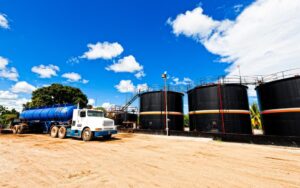
(S&P Global Platts, 30.Nov.2021) — Oil production by Venezuela’s state PDVSA and its foreign partners rose to 660,000 b/d in November, up 40,000 b/d from October, Nov. 30 PDVSA production reports reviewed by S&P Global Platts showed.
Orinoco Belt output rose to 420,000 b/d, up 40,000 b/d from the 380,000 b/d reported in October. Crude production at the Monagas fields rose to 130,000 b/d, an increase of 10,000 from October. Zulia-Trujillo production remained at 110,000 b/d. Condensate production fell to zero from 10,000 b/d in October, according to the reports.
The recovery of production, especially in the Orinoco Belt, has been possible by the import of diluents from Iran, the reports showed. The 8.5% API extra-heavy crude extracted from the Orinoco Belt can only be marketed if it undergoes an upgrading process by blending it with light crude, condensates or naphtha.
PDVSA’s diluent inventories, used to upgrade extra-heavy crude, totaled 1.7 million barrels in November, the highest level since 2019 when its imports of naphtha and light crude were halted due to US sanctions. Diluent inventories had reached their lowest level of 12,000 barrels in September, when PDVSA then received condensate imports from Iran, a country that also faces US sanctions. At end-September, PDVSA received 2 million barrels of condensate from Iran and on Oct. 25 a second of 2.1 million barrels. By end-November, PDVSA expected another cargo of 2 million barrels from Iran. This cargo was expected at the Jose terminal in northeastern Venezuela between Nov. 27-29, according to the internal report.
Iran and Venezuela have traded consignments of Iranian gasoline and condensates in exchange for Venezuelan Merey 16 crude oil since last year.
However, Venezuela’s production recovery is not enough to meet the goals announced by Oil Minister Tareck el Aissami, who in April said he would bring production to 1.5 million b/d by the end of the year, a target that looks unattainable. In November, oil production was 740,000 b/d below the targets of the recovery plan.
The PDVSA production reports gave details about the joint-venture companies in the four main blocks of the Orinoco Belt: Carabobo, Ayacucho, Junín and Boyacá. In these blocks, PDVSA has formed seven joint ventures, with another nine in development stages.
According to the reports, average crude output during November in the Carabobo block was 191,000 b/d; in Ayacucho 140,000 b/d; in Junín 80,000 b/d, and in Boyaca 9,000 b/d.
In the Carabobo block, the Petrolera Sinovensa joint venture (PDVSA 60%, CNPC 40%) operated at an average 90,000 b/d, Petromonagas (PDVSA 60%, Russia 40%) processed 80,000 b/d. In the Ayacucho block, Petropiar, a joint venture between PDVSA 70% and Chevron 30% operated at an average 75,000 b/d in November. Production at the Morichal and San Tome fields, which are 100% owned and operated by PDVSA in the Orinoco Belt, was 130,000 b/d in total. The average added production in the rest of the blocks at Orinoco Belt was 45,000 b/d.
In Monagas state oil fields, in eastern Venezuela, production averaged 130,000 b/d, 10,000 b/d over October. Aggregated average output in oil fields located in western Zulia and Trujillo states remains at 110,000 b/d.
The internal document reviewed by Platts contains preliminary and unofficial information that can change at a later date.
PDVSA did not respond immediately to a request for comment.
____________________

